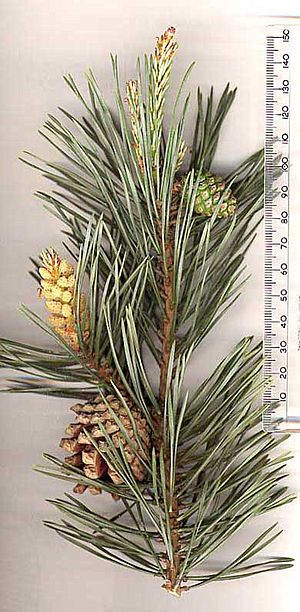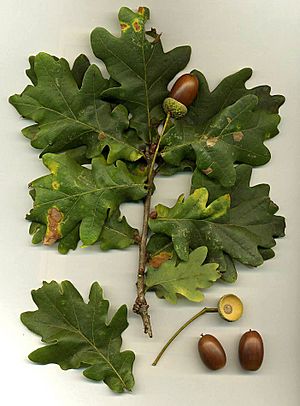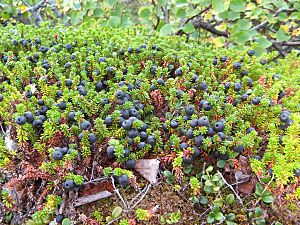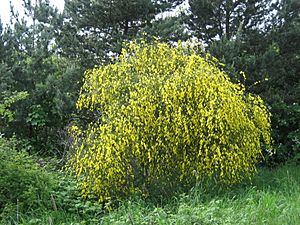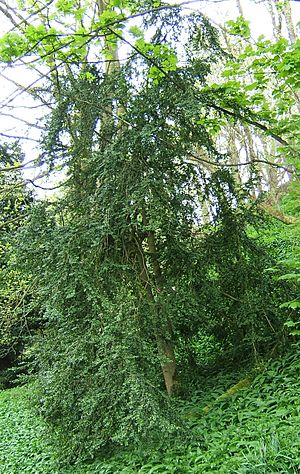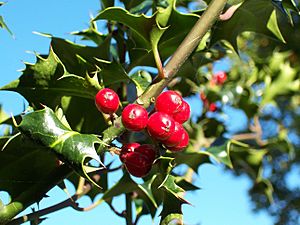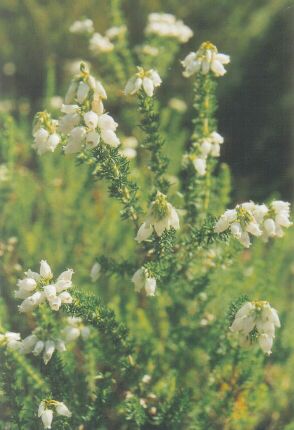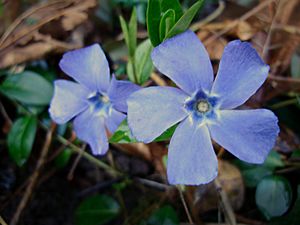Clan badge facts for kids
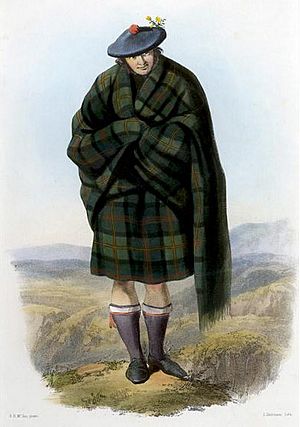
A clan badge, sometimes called a plant badge, is a badge or emblem, usually a sprig of a specific plant, that is used to identify a member of a particular Scottish clan. They are usually worn affixed to the bonnet behind the Scottish crest badge, or pinned at the shoulder of a lady's tartan sash. According to popular lore clan badges were used by Scottish clans as a means of identification in battle. An authentic example of plants being used in this way (though not by a clan) were the sprigs of oats used by troops under the command of Montrose during the sack of Aberdeen. Similar items are known to have been used by military forces in Scotland, like paper, or the "White Cockade" (a bunch of white ribbon) of the Jacobites.
Authenticity
Despite popular lore, many clan badges attributed to Scottish clans would be completely impractical for use as a means of identification. Many would be unsuitable, even for a modern clan gathering, let alone a raging clan battle. Also, a number of the plants (and flowers) attributed as clan badges are only available during certain times of year. Even though it is maintained that clan badges were used long before the Scottish crest badges used today, according to a former Lord Lyon King of Arms the oldest symbols used at gatherings were heraldic flags such as the banner, standard and pinsel.
There is much confusion as to why some clans have been attributed more than one clan badge. Several 19th century writers variously attributed plants to clans, many times contradicting each other. It has been claimed by one writer that if a clan gained new lands it may have also acquired that district's "badge" and used it along with their own clan badge. It is clear however, that there are several large groups of clans which share badges and also share a historical connection. The Clan Donald group (clans Macdonald, Macdonald of Clanranald, Macdonell of Glengarry, MacDonald of Keppoch) and clans/septs which have been associated with Clan Donald (like certain MacIntyres and the Macqueens of Skye) all have common heath attributed as their badge. Another large group is the Clan Chattan group (clans Mackintosh, Macpherson, Macgillivray, Macqueen, Macbain, Farquharson, Davidson) which have been attributed red whortleberry (sometimes called cranberry in Scotland), or bearberry, or boxwood. The leaves of these three plants are very similar, and at least one writer has claimed that whatever plant which happened to be available was used. One group, the Siol Alpin group, of clans are said to have claimed or are thought to share a common descent. The Siol Alpin clans (clans Grant, Gregor, MacAulay, Macfie, Macnab, Mackinnon, Macquarrie) are all attributed the clan badge of pine (Scots fir). In some cases, clan badges are derived from the heraldry of clan chiefs. For example, the Farquharsons have pine attributed as a clan badge of theirs (pine also appears on the uniforms of the Invercauld Highlanders). Pine was actually used in the Invercauld Arms as a mark of cadencing to the basic Shaw-Mackintosh Arms.
Plants used as badges
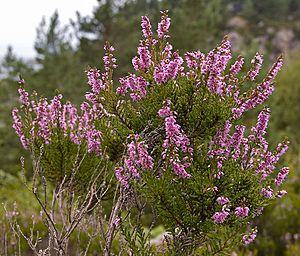
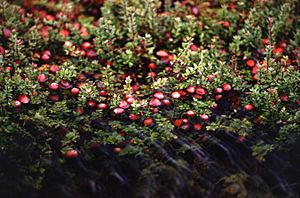
| Clan name | Plant badge attributed to the clan | Notes |
|---|---|---|
| Arthur | wild myrtle | |
| fir club moss | ||
| Boyd | Laurel leaves | |
| Brodie | periwinkle | |
| Bruce | rosemary | |
| Buchanan | billberry (blaeberry) | |
| oak | ||
| birch | ||
| Cameron | crowberry | |
| oak | ||
| Campbell | fir club moss | |
| wild myrtle (or bog myrtle) | Though abundant in Argyll, Bog Myrtle drops its leaves in winter. | |
| Chattan | wild whortleberry | |
| Chisholm | fern | |
| Cochrane | sea holly | |
| Colquhoun | hazel | |
| dogberry | ||
| Cumming | common sallow; i.e., the ... willow | |
| Davidson | boxwood | |
| red whortleberry | ||
| Donnachaidh | bracken, or fern | The Celtic Magazine of 1884 states that this badge (fern), compared to fine leaved heath, is the older badge. |
| fine leaved heath | ||
| Drummond | holly | |
| Wild thyme | ||
| Farquharson | Scots fir | |
| red whortleberry | ||
| foxglove | ||
| Fergusson | little sunflower | |
| Forbes | broom | |
| Fraser | yew | |
| Gordon | ivy | |
| Graham | Laurel | Originally the badge was Spurge Laurel, but as that plant is poisonous and not indigenous to Scotland, James, 8th Duke of Montrose petitioned the Lord Lyon to have the True Laurel (Laurus Nobilis) recognised as the clan plant badge, which petition he was granted. |
| Grant | pine (Scots fir) | |
| Gregor | pine (Scots fir) | |
| Grierson | Scottish bluebell | |
| Gunn | juniper | |
| roseroot | ||
| Hannay | periwinkle | |
| Hay | mistletoe | |
| Henderson | cotton grass | |
| Home | broom | |
| Innes | great bulrush | |
| Jardine | apple blossom | |
| Johnstone | red hawthorn | |
| Kennedy | oak | |
| Lamont | crab-apple tree | |
| trefoil | ||
| dryas | ||
| Logan | furze | |
| MacAlister | common heath | |
| MacAulay | pine (Scots fir) | |
| cranberry | ||
| MacBain | boxwood | |
| red whortleberry | ||
| MacDonald | common heath (Scots heather) | |
| Macdonald of Clanranald | common heath | |
| MacDonald of Keppoch | common heath | |
| white heather | ||
| MacDonell of Glengarry | common heath | |
| MacDougall | bell heather | |
| cypress | ||
| MacDuff | boxwood | |
| red whortleberry | ||
| Macfarlane | cranberry | |
| cloudberry | ||
| Macfie | pine (Scots fir) | |
| oak | ||
| crowberry | ||
| MacGillivray | boxwood | |
| red whortleberry | ||
| MacInnes | holly | |
| MacIntyre | common heath | |
| Mackay | great bulrush | |
| heather | ||
| Mackenzie | variegated holly | |
| deer's grass (heath club rush) | Innes of Learney claimed that heath club rush ('deer's grass') may be confused with club moss ('staghorn moss'). Club moss has also been attributed to the Macraes, who were the Mackenzie's "shirt of mail". Even if it is a confusion both 'deer's grass' and 'staghorn moss' likely refer to caberfeidh ("deer's antlers") in the Mackenzie chiefly arms. | |
| Mackinnon | pine (Scots Fir) | |
| St John's wort (St. Columba's flower) | ||
| Mackintosh | red whortleberry | |
| bearberry | ||
| boxwood | ||
| Maclachlan | rowan (mountain ash) | |
| lesser periwinkle | ||
| Maclaine of Lochbuie | bilberry (blaeberry) | |
| bramble | ||
| holly | ||
| black berry heath | ||
| MacLaren | laurel | |
| MacLea | The Flower of the Grass of Parnassus. | |
| Maclean | crowberry | |
| holly | ||
| MacLennan | furze | |
| MacLeod | juniper | |
| Macleod of the Lewes | red whortleberry | |
| MacMillan | holly | |
| Macnab | stone bramble | |
| common heath | ||
| Macnaghten | trailing azalea | |
| MacNeil | Dryas (avens) | |
| trefoil | This clan badge may actually be attributed to the McNeills of Gigha, a branch of Clan MacNeil. Trefoil has also been attributed to the Lamonts, another clan in Argyl. The Lamonts and MacNeils/McNeills both claim descent from the same O'Neill who settled in Scotland in the Middle Ages. | |
| Macpherson | white heather | |
| boxwood | ||
| red whortleberry | ||
| Macquarrie | pine (Scots fir) | |
| Macqueen | boxwood | |
| red whortleberry | ||
| Macrae | club moss | Club moss sometimes referred to as staghorn grass, may refer to the Mackenzie chiefly arms, or at least the Macrae's close association with the Mackenzies. |
| Malcolm (MacCallum) | rowan berries | |
| Matheson | broom | |
| holly | ||
| Menzies | Menzies's heath | Probably intended to be blue heath, Phyllodoce caerulea, a very rare member of the heather family, Ericaceae, found on several Scottish mountains. Its scientific name has changed since it was first found more than two centuries ago on the Sow of Atholl, but for much of the 19th century it was called Menziesia caerulea. Hence the reputed association with Clan Menzies. Menziesia was coined by James Edward Smith in 1793 to honour the Scottish physician and naturalist Dr Archibald Menzies (1754- 1842) who was attached to Capt. George Vancouver's circumnavigation, 1790-1795. The original ("type") species was Menziesia ferruginea, now named Rhododendron menziesii, a native of northwestern North America. No plants are now assigned to Menziesia which has been subsumed into Rhododendron. The name "Menzies's heath" is unknown in botanical literature. |
| ash As mentioned | ||
| Moncreiffe | oak | Oak-leaves appear on a stone carving of the 12th laird's heraldic mantling of 1634. |
| Morrison | driftwood | |
| Munro | common club moss | |
| Murray | butcher's broom | |
| juniper | ||
| Nicolson | juniper | |
| Ogilvy | whitethorn, hawthorn | |
| evergreen alkanet | ||
| Oliphant | bull rush | |
| Ramsay | blue harebell | |
| Rose | wild rosemary | |
| Ross | juniper | |
| bearberry | The 19th-century historian W. F. Skene listed this clan's badge as uva ursi, which is sometimes known as bearberry. | |
| Seton | yew | |
| Scott | blaeberry | |
| Sinclair | furze (whin) | |
| white clover | ||
| Stewart | oak Thistle | |
| Sutherland | butcher's broom, cotton sedge | |
| Urquhart | wallflower, gillyflower | |
| Wood | Oak | The oak is featured prominently on the shields of all the Woods' coats of arms. |
See also


